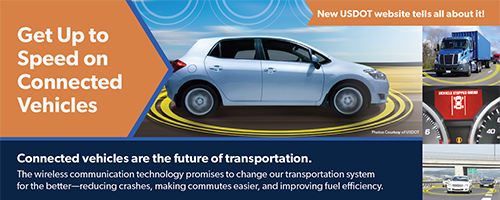Research Archive
Pilot Sites
The USDOT has selected three Wave 1 pilot sites, who are in the process of conducting Phase 1 concept development activities in order to further advance the proof of concept and to move towards the deployment and operations phases.
ICF/Wyoming
The primary objective for the CV Pilot ICF/Wyoming pilot deployment is to reduce the number of weather related incidents (including secondary incidents) in the corridor in order to improve safety and reduce incident-related delays. This deployment will utilize connected vehicle technology to improve and monitor performance on Interstate 80 (I-80), which is a freight-intensive corridor with a daily volume of 11,000 to 16,000 vehicles, many of which are heavy-duty trucks (30% to 55%). The I-80 corridor is about 402 miles long and reaches its maximum elevation of 8,640 feet above sea level at Sherman Summit, near Buford (See the figure below). As a result of the high elevation, the corridor is particularly subject to winter weather events, most commonly between the months of October and May. Weather events typical to the corridor are ice and snow covered road surfaces, poor visibility, and high wind events (i.e., wind speeds exceeding 30 mph and wind gusts exceeding 40 mph) that often lead to truck blow-overs. Between 2002 and 2012, more than 3,470 high-wind crashes were observed. This Pilot will develop applications that use vehicle to infrastructure (V2I) and vehicle to vehicle (V2V) connectivity to support a flexible range of services that improves safety and mobility. Information from these applications will be made available directly to the equipped fleets or through data connections to fleet management centers, that will then communicate it to their trucks using their own systems. The applications to be deployed include Road Weather Advisories and Warnings for Motorists and Freight Carriers, Weather-Responsive Variable Speed Limit System, Freight-Specific Dynamic Travel Planning, Spot Weather Impact Warning, Situational Awareness, and others as determined by the user needs of truck drivers, fleet managers in the corridor. Wyoming DOT will conduct the pilot in three phases as directed by the federal contract. In the first phase which elaborates the deployment concepts, Wyoming DOT will be supported by a multidisciplinary team including ICF International, University of Wyoming, National Center for Atmospheric Research, Trihydro, University of Maryland - Center for Advanced Transportation Technologies, and McFarland Management. Additional partners and stakeholders will be engaged in the development and deployment phases of the pilot.

(Source: http://www.its.dot.gov/pilots/pdf/04_CVPilots_Wyoming.pdf)
ID |
Category |
ICF/WYDOT – CV Application |
1 |
V2V Safety |
Forward Collision Warning (FCW) |
2 |
V2I/I2V Safety |
I2V Situational Awareness* |
3 |
Work Zone Warnings (WZW)* |
|
4 |
Spot Weather Impact Warning (SWIW)* |
|
5 |
V2I and V2V Safety |
Distress Notification (DN) |
ICF/WYDOT Plans to deploy a total of five V2V and V2I Safety applications. The applications marked with asterisk have mobility/efficiency as a secondary benefit.
ICF/WYDOT – Devices |
Estimated Number |
Roadside Unit (RSU) |
75 |
WYDOT Fleet Subsystem On-Board Unit (OBU) |
100 |
Integrated Commercial Truck Subsystem OBU |
150 |
Retrofit Vehicle Subsystem OBU |
20-30 |
Basic Vehicle Subsystem OBU |
100-150 |
Total Equipped Vehicles |
400 |
New York City (NYC)
The primary objective of the CV Pilot NYC pilot deployment site to improve the safety of travelers and pedestrians in New York City through connected vehicle technologies. This objective of the CV Pilot NYC is directly aligned with the New York City’s Vision Zero initiative, which seeks to reduce pedestrian fatalities and make the City’s streets safer for travelers in all modes of transportation. This NYC site provides an ideal opportunity to evaluate the CV technology and applications in tightly-spaced intersections typical in a dense urban transportation system. Connected vehicle technologies and associated applications will be deployed along heavily traveled high accident rate arterials in Manhattan and Brooklyn (as shown in the figure below) to provide a comparative sample that can be used to verify benefits against those for locations that are not instrumented. The NYC pilot deployment will feature the installation and utilization of vehicle to vehicle (V2V) technology in up to 10,000 city-owned and other fleet vehicles. Traffic signals in the high-priority corridors in Manhattan and Brooklyn will be upgraded with vehicle to infrastructure (V2I) communications capabilities. Applications to be deployed include Red Light Violation Warning, Pedestrian in Signalized Crosswalk Warning, Vehicle Turning Right in Front, Mobile Accessible Pedestrian Signal System (PED-SIG), and Freight-Specific Dynamic Travel Demand and Performance, to help reduce congestion and control speeds, enhance intersection and pedestrian safety, and optimize truck freight operations. The New York City Department of Transportation leads this deployment effort.

New York City Pilot Deployment Site Map
(Source: http://www.its.dot.gov/pilots/pdf/02_CVPilots_NYC.pdf)
ID |
Category |
NYCDOT – CV Application |
1 |
V2I/I2V Safety |
Speed Compliance |
2 |
Curve Speed Compliance |
|
3 |
Speed Compliance/Work Zone |
|
4 |
Red Light Violation Warning |
|
5 |
Oversize Vehicle Compliance |
|
6 |
Emergency Communications and Evacuation Information |
|
7 |
V2V Safety |
Forward Crash Warning (FCW) |
8 |
Emergency Electronics Brake Lights (EEBL) |
|
9 |
Blind Spot Warning (BSW) |
|
10 |
Lane Change Warning/Assist (LCA) |
|
11 |
Intersection Movement Assist (IMA) |
|
12 |
Vehicle Turning Right in Front of Bus Warning |
|
13 |
V2I/I2V Pedestrian |
Pedestrian in Signalized Crosswalk |
14 |
Mobile Accessible Pedestrian Signal System (PED-SIG) |
|
15 |
Mobility |
Intelligent Traffic Signal System (I-SIGCVDATA) |
NYCDOT Plans to deploy a total of six V2I/I2V Safety, six V2V Safety, two V2I/I2V Pedestrian and one Mobility applications.
NYCDOT – Devices |
Estimated Number |
Roadside Unit (RSU) at Manhattan and Brooklyn Intersections and FDR Drive |
353 |
Taxi Equipped with Aftermarket Safety Device (ASD)* |
5,850 |
MTA Fleet Equipped with ASD* |
1,250 |
UPS Truck Equipped with ASD* |
400 |
NYCDOT Fleet Equipped with ASD* |
250 |
DSNY Fleet Equipped with ASD* |
250 |
Vulnerable Road User (Pedestrians/Bicyclists) Device |
100 |
PED Detection System |
10 + 1 spare |
Total Equipped Vehicles |
8,000 |
MTA: Metropolitan Transportation Authority; DSNY: City of New York Department of Sanitation
*In addition, 600 spare ASDs will be purchased.
Tampa (THEA)
This pilot deployment effort, headed by the Tampa-Hillsborough Expressway Authority (THEA), will deploy a variety of connected vehicle technologies on and within the vicinity of the Lee Roy Selmon Expressway reversible express lanes in downtown Tampa (shown below in the figure). In addition to the Expressway, the deployment area contains bus and trolley services, high pedestrian densities, special event trip generators and highly variable traffic demand over the course of a typical day. These diverse travel demand environments in a single concentrated deployment area create a wide variety of dynamic traffic conditions. Drivers within the deployment area experience significant delays (especially on the Selmon Expressway) during the morning peak hour resulting in, and often caused by, a correspondingly large number of rear-end crashes and red light running collisions. The deployment area also experiences transit signal delays, pedestrian conflicts, red light running and signal coordination issues. Hence, the primary objective of this deployment is to alleviate congestion on the roadway during morning commuting hours. In addition, the project team will deploy a variety of vehicle-to-vehicle (V2V) and vehicle-to-infrastructure (V2I) safety, mobility, and agency data applications to create reinforcing benefits for motorists, pedestrians, and transit operation. Some of the applications to be deployed include Curve Speed Warning, Intelligent Traffic Signal System, Intersection Movement Assist, Mobile Accessible Pedestrian Signal, and Transit Signal Priority.
For more information of the site, please go to Tampa (THEA) website: http://www.tampa-xway.com/Projects/ConnectedVehiclePilotProgram.aspx

Connected Vehicle Pilot Deployment-Downtown Tampa
(Source: http://www.its.dot.gov/pilots/pdf/03_CVPilots_Tampa.pdf)
ID |
Category |
Tampa (THEA) – CV Application |
1 |
V2I Safety |
Curve Speed Warning (CSW) |
2 |
Pedestrian in Signalized Crosswalk Warning (PED-X) |
|
3 |
Red Light Violation Warning (RLVW) |
|
4 |
V2V Safety |
Emergency Electronic Brake Lights (EEBL) |
5 |
Forward Collision Warning (FCW) |
|
6 |
Intersection Movement Assist (IMA) |
|
7 |
Vehicle Turning Right in Front of a Transit Vehicle (VTRFTV) |
|
8 |
Mobility |
Mobile Accessible Pedestrian Signal System (PED-SIG) |
9 |
Intelligent Traffic Signal System (I-SIG) |
|
10 |
Transit Signal Priority (TSP) |
|
11 |
Agency Data |
Probe-enabled Data Monitoring (PeDM) |
THEA plans to deploy a total of three V2I Safety, four V2V Safety, three Mobility and one Agency Data applications.
Tampa (THEA) – Devices |
Estimated Number |
Roadside Unit (RSU) at Intersection |
40 |
Vehicle Equipped with On-Board Unit (OBU) |
1,500 |
Pedestrian Equipped with App in Smartphone |
500 |
HART Transit Bus Equipped with OBU |
10 |
TECO Line Street Car Equipped with OBU |
10 |
Total Equipped Vehicles |
1,520 |














